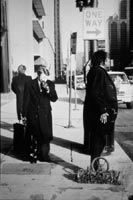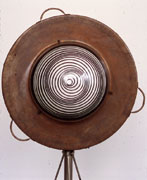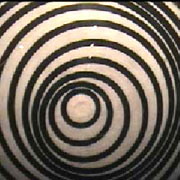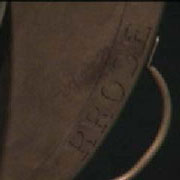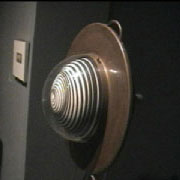click images to enlarge
Four images from: Sanford Biggers, Duchamp in the Congo (Suburban Invasion), Performance 1999 Photo: Art Meyers
Dressed in a suit and tie, Sanford Biggers entered a Chicago diner teeming with businesspeople. Briefcases in hand, they exchanged small talk and serious nods. Biggers clung to his own briefcase while slowly taking a seat, alone, at the counter to order breakfast. At their tables, diners drank coffee and held open newspapers. But between crisp folds and shuffles of the news in front of them, they noticed a very different text at Biggers’ side. Biggers, perhaps unbeknownst to his audience, was performing Duchamp in the Congo (Suburban Invasion) , his latest performance. His “newspaper” was Hangman’s House , the first of two artworks created for the performance. Hangman’s House is an old, fraying hardcover book entitled Hangman’s House , through which Biggers drove nails and sharp objects to puncture the cover and pages inside.
Biggers, 31, is an artist who now resides in New York City after living in other American and international cities. In a rare confluence, he applies Dadaist techniques to reconsider objects of power, cultural signatures, and African traditions. To objects of contemporary familiarity, Biggers adds symbolic and traditional elements, some mundane and others seemingly misplaced, to forge postmodern tributes to the African roots of modernism.
As Biggers carried Hangman’s House while performing Duchamp in the Congo (Suburban Invasion), the only words legible were those of the book title. When he exhibits the book outside the context of his performance, he uses a bookstand which spreads the covers open to reveal the entire piece. The piece rests on a transparent surface and a mirror underneath the book reveals some cover text on the underside.
The second piece Biggers created for the performance shares the title of the performance, Duchamp in the Congo. A wheel sits on the inside of a block of wood, pushing through its surface. Leather straps, twine, rope, and various fibers tightly tie the wheel to the block of wood. This construction is Biggers’ briefcase– the wheel extends from the block to form a handle.
click to enlarge

Figure 1
Hangman’s HouseUnited States: New York:
Century, 1926 and United Kingdom: London:
Sampson Low, Marston, 1926)
The book, now out of print, is a story by
Donn Byrne about an Irish judge who sentences
several people to a hanging death and urges his
daughter against her will to marry a man who
becomes the target of an avenger. The story
was made into a movie directed by John Ford in 1928.
The form of Duchamp in the Congo draws on traditional African rituals, specifically those involving the captivity of spirits and their power ( minkisi ) into objects. Nail figures (or nkisi n’kondi), were traditionally carved by indigenous people within the Congo in the late 19th and early 20th centuries and symbolize a ritual of collective oath-taking in which participants drive nails or sharp iron pegs into an object of power to symbolize their agreement and compliance with community codes, customs, and mores. Each stake remains where driven, and each individual’s penetration into the object qualifies their commitment while further activating the power of the figure to guard and secure the community.
To frame his performance, Biggers imagined what Marcel Duchamp would have created having traveled to the Democratic Republic of the Congo. He depicts a fictitious trip that Duchamp took to study African works of art and then create an nkisi-influenced or nail-inundated wheel.
Biggers explained that after he created the two pieces for Duchamp in the Congo (Suburban Invasion) , the next step was his execution of a ritual. He chose to perform a present-day activity to echo traditional rituals of collective oath-taking: dressed as a businessman he enacted a typical commute to work, and displayed Duchamp in the Congo and Hangman’s House by carrying the two through the streets of Chicago during rush hour.
For a commuting suburban audience, Biggers clings to his own spiky “briefcase” while reading Hangman’s House, with its sprouting nails, as his newspaper. Carrying his artworks as he would everyday objects in familiar ways down busy streets, he reads his paper as if curious to learn something new. By imitating the form of a daily trip to work while contradicting it with the content of the objects he holds, he draws his audience directly to his art. Biggers challenges commuters to glance beyond their everyday concerns and the certainty of their paths to examine the symbols of the collective oath they take to perceive, inquire, and behave as they do everyday.
Beyond a Dadaist appeal to more closely examine commonly perceived truths, Duchamp in the Congo (Suburban Invasion) revives other salient themes introduced by modernists in the early and mid nineteenth century. By performing during rush hour, Biggers blurs the boundaries between art and everyday life and engages the public in a live dialogue. By adopting African rituals, he makes the inspiration of non-industrialized, non-Western cultures and values on modernism explicit. He revisits a time when artists typically looked at traditions from Africa, Asia, and the pre-Columbian Americas to define modernism and he continues in the current era where they left off. Each piece made for the performance is a retrospective of modern art from the post-modern perspective. The wheel included in Duchamp in the Congo serves as a reference to Duchamp’s Bicycle Wheel (Fig. 2).
click images to enlarge
-
Figure 2
The Bicycle Wheel, 1913, is Duchamp’s first “Readymade”
While it has been “lost,” scholars have found at least 5
photos of it in his New York studio. The irregular leg
positions of the stools and the tilt of the wheel and
fork were never (one could argue) in equilibrium. In fact,
Duchamp would have had to glue the stools into their
irregular shapes, and tie string to support the five
bicycle wheels and stools, in order to permit
them even to stand, let alone spin.
-
Figure 3
Nkisi n’kondi, 19th century
As Biggers explained it to me, “before a ceremony, ritual or some celebratory act that the whole community is involved in, people walk by the sculpture or image and pound nails, shards of glass, and sharp or reflective objects into the piece. The piece becomes a power object not only by the veneration that this group of people put on the piece, but the physical activity of pounding and hammering into the piece. Later, the piece itself acts almost as a type of scarecrow to ward off enemies, evil spirits and others who may harm the group. So in the case of the Hangman’s House, I used that as an aesthetic metaphor for banishing the history of America, being the Hangman’s House, the house of so much lynching. In terms of Duchamp in the Congo , I was using the nails to go against the notion of modernism and primitivism, so in this case instead of warding off physical spirits or enemies, there is a warding off in the psychological or philosophical sense of erroneous notions and traces of modernism, primitivism, and post-modernism.”
In the photographs of Biggers on a train during the performance, people look at him inquisitively. He recalls standing on a corner in downtown Chicago where another man behind him, briefcase and newspaper in hand, gives him incredulous looks as if to confront him. But this type of response reveals the larger confrontation at work by Biggers. As he elaborated, “I follow the idea of keeping the form as one of the most important elements but also feel strongly about challenging prescribed notions in art theory. The fact that I am the creator or author of these pieces also adds to how these pieces are interpreted by art theory. In that respect, I think it follows that Duchamp’s Dada approach is to juxtapose objects and concepts with the norm.”
click to enlarge

Figure 4
Mandala of the B-Bodhisattva II
Sanford Biggers and David Ellis, 2000

Figure 5
Mandala of the B-Bodhisattva I
Sanford Biggers, 1999

Figure 6
Disks Bearing Spirals
Marcel Duchamp, 1923
Biggers collaborated with another artist, David Ellis, for a break dancing mat project, Mandala of the B-Bodhisattva II , 2000. Ellis focused on preserving the idea of Duchamp’s Rotoreliefs of 1935, six double-sided optical disks made after prior experiments with optics such as Disks Bearing Spirals of 1923 or Rotary Demisphere (Precision Optics) of 1925. Each one of the Rotoreliefs bears a spiral, eccentric-circle, or similar design. When placed on a record player or other spinning circle, the Rotoreliefs create an optical illusion of depth, intensified when looking with one eye rather than two. I asked Biggers about connections between the mats and the Dadaist celebration of mechanical methods apparent in the Rotoreliefs.
Biggers replied, “my approach had to do more with the Mandala, so there was an overlap there in terms of the circle-based art form, but for me the Rotorelief was not used as literally as in Ellis’ work. However, the motive was to use the concept on a more geometrical level with the juxtaposition of circles as well as other geometries to create the illusion of movement. To enhance this effect, the dancers create the movement as opposed to a turntable’s rotation.”
He continues, “One reason we worked on this project was my fascination with the Mandala and Ellis’ fascination with the Rotorelief for shared conceptual and aesthetic reasons. We have both been DJs and are deeply into preserving hip hop culture. For us it was the idea of spinning and turning more importantly than the Mandala or the Rotorelief, but these were ways for us to deal with the idea of the spin–the backspin, the spin of a skateboard wheel, or the spin of the turntable–and finding a graphic representation of that idea. The spin is also important in that it goes back to several traditions–whirling dervishes and other dancers going into trance, in Yoruba and Vodoun ceremonies. This reminds me of an interesting fact about the Mandala–sometimes monks don’t actually draw or depict the Mandala, but they remember the patterns and then dance and jump in circles to form it with their own motions. We know the trace and graphic depiction of the Mandala and the Rotorelief, but I thought it was interesting to explore how to experience or create the sense of movement as the actual depiction.”
click images to enlarge
Rotary Demisphere (Precision Optics)
Marcel Duchamp, 1925
Biggers recommends They Came Before Columbus for this issue’s Bookstore section. Upon hearing this suggestion, I mention a review of the PS1 show at New York City’s Clocktower Gallery last year. One of the artists, David Godbold, did a cynical piece about the Mayflower, using a comic-like motif against a traditional piece. His installation, entitled America[s] Disclosed 2000 , is a wall painting that presents the initial discovery of America by the Europeans as erroneous. Biggers comments that Godbold’s piece “looks at colonialism, dispelling the belief of Manifest destiny, the grand romanticism of colonialism and the current reality of post-colonialism both here in America and Cuba as well as the relationships between sovereign and colonial nations and the people that they colonize. My work touches on the colonial and post-colonial history of the African Diaspora, however, I use Africa more as a metaphor for African America, and not the other way around. It also relates to what we mentioned of art theory and that being a type of colonial mentality.”
For my last question, I inquire about any connections between Duchamp’s concept of a ready-made item and items found in Biggers’ work. I wondered specifically about Biggers’ appropriation of objects to explore issues of class and race. Biggers replies that although he was trained as a painter, he began to take more interest in making three-dimensional objects. He describes that one of the things drawing him to this decision was the realization that objects found on the street, often marked by a particular type of use and treatment and grouped with other objects, often already said what he intended to create. “It isn’t about depicting–it’s about seeing authenticity right in front of you.” Biggers elaborates,”‘Use patina,’ the way the paint falls off, the way a chair is rubbed on the arms because someone kept sitting in the chair in the same way over time, molding the chair itself– it serves as a quiet tribute to history. Different areas where I would find materials, like a poor neighborhood in Baltimore versus an upper class neighborhood in Japan, said different things. I started to find out what areas had different items to collect. I could find a piano for example, in one part of town, where somebody might just throw that kind of thing out. A physical mapping of various cities began to emerge based on the artifacts I found in certain neighborhoods. I have used this approach in several countries and it gave me an “in” to the social geography of any given region. I was originally drawn to objects that were used by individuals and later become interested in mass produced materials that were used by many people. For example, the color tiles that are used in the Mandalas are the same tiles used on the subway and bus floor of Brooklyn, Harlem, and most of Inner-City U.S.A.”
In his work, Biggers provides us with the synthesis of the mundane and the extraordinary, historical testimony and present-day realism, tradition and transformation.
click images to enlarge

Sanford Biggers, Hangman’s
House, 1999
Fig(s). 2, 6, 7
©2005 Succession Marcel Duchamp, ARS, N.Y./ADAGP, Paris. All rights reserved.






